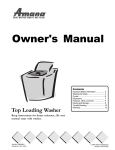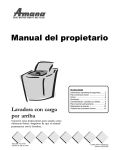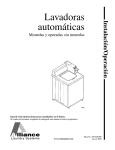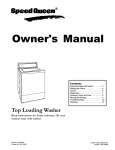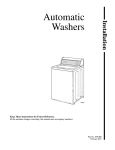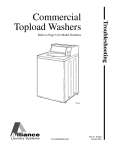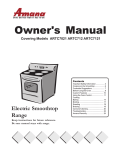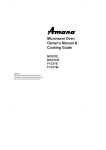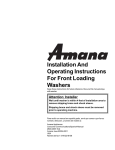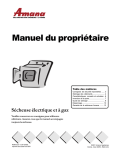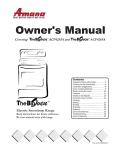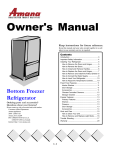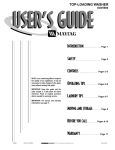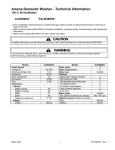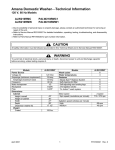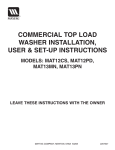Download Owner`s Manual
Transcript
Owner’s Manual Top Loading Washer Keep instructions for future reference. Be sure manual stays with washer. Contents Important Safety Information ..................................... 2 Product Registration and Service .............................. 3 Before You Install ..................................................... 4 Installation Instructions ............................................. 6 Helpful Hints and Features ....................................... 8 Care and Cleaning .................................................... 9 Operating Instructions ............................................ 10 Troubleshooting/Before Calling Service ................... 12 Warranty ................................................................ 14 Installer Checklist ................................................... 16 Important Safety Information Recognize Safety Symbols, Words, Labels 13. Use your washer only for its intended purpose: non-commercial clothes washing. 14. Always disconnect washer from electrical supply before attempting any service. Disconnect power cord by grasping the plug, not the cord. 15. Install washer according to Installation Instructions. All connections for water, drain, electrical power, and grounding must comply with local codes and be made by licensed personnel when required. 16. To reduce risk of fire, do not use washer to launder clothes which have traces of any flammable substance, such as vegetable oil, cooking oil, machine oil, flammable chemicals, thinner, etc., or anything containing wax or chemicals, such as mops and cleaning cloths. Flammable substances may cause fabric to catch fire by itself. 17. Use only fabric softeners or products to eliminate static that are appropriate for automatic washers. 18. Keep your washer in good condition. Bumping or dropping washer can damage safety features. If damage occurs, have washer checked by qualified service technician. 19. Replace worn power cords and/or loose plugs. 20. Loading door must be closed whenever washer is filling, agitating, or spinning. Do not bypass loading door switch by permitting washer to operate with loading door open. 21. Always read and follow manufacturer’s instructions on packages of laundry and cleaning aids. Heed all warnings or precautions. To reduce risk of poisoning or chemical burns, keep products away from children at all times, preferably, in a locked cabinet. 22. Never operate washer with guards and/or panels removed. 23. Do not operate washer with missing or broken parts. 24. Do not bypass safety devices. 25. Failure to install, maintain, and/or operate washer according to manufacturer’s instructions may result in conditions which can produce bodily injury and/or property damage. ! DANGER DANGER—Immediate hazards which WILL result in severe personal injury or death. ! WARNING WARNING—Hazards or unsafe practices which COULD result in severe personal injury or death. ! CAUTION CAUTION—Hazards or unsafe practices which COULD result in minor personal injury or product or property damage. ! WARNING To reduce risk of fire, electric shock, serious injury, or death when using your washer, follow these basic precautions: 1. Read all instructions before using washer. 2. Be sure washer is properly grounded. 3. Do not wash articles that have been cleaned in, washed in, soaked in, or spotted with gasoline, dry-cleaning solvents, or other flammable or explosive substances. Vapors could ignite or explode. 4. Do not add gasoline, dry-cleaning solvents, or other flammable or explosive substances to wash water. Vapors could ignite or explode. 5. Do not store or use gasoline or other flammable vapors and liquids near this or any other appliance. 6. Do not allow children to play on or in washer. Close supervision of children is necessary when washer is used near children, a safety rule for all appliances. 7. Before washer is removed from service or discarded, remove door to washing compartment. 8. Do not reach into washer if wash tub is moving. 9. Do not install or store washer where it will be exposed to water and/or weather. 10. Do not tamper with washer controls. 11. Do not repair or replace any part of washer or attempt any service, unless specifically recommended in user-maintenance instructions or in published user-repair instructions that you understand and have skills to carry out. 12. To reduce risk of electric shock or fire, do not use extension cords or adapters to connect washer to electrical power source. NOTE: Warning and Important Safety Instructions appearing in this manual are not meant to cover all possible conditions and situations that may occur. Common sense, caution, and care must be exercised when installing, maintaining, or operating washer. Always contact your dealer, distributor, service agent, or manufacturer about problems or conditions you do not understand. 2 Important Information Thank you for buying an Amana washer! Please take the time to complete the registration card and return promptly. If registration card is missing, call Amana Consumer Affairs Department. When contacting Amana, provide product information from serial plate found on lower right hand corner of inner lid: Model Number __________________________________ Manufacturing (P) Number _________________________ Serial Number (S/N) ______________________________ Purchase Date __________________________________ Dealer Name ___________________________________ Dealer Address _________________________________ Dealer Phone ___________________________________ Keep this manual and your sales receipt together in a safe place for future reference or if warranty service is required. For answers to questions or to locate an authorized servicer, call 1-800-NAT-LSVC (1-800-628-5782) inside USA or 319-622-5511 outside USA. Warranty service must be performed by an authorized servicer. Amana Appliances also recommends contacting an authorized servicer if service is required after warranty expires. Asure™ Extended Service Plan Amana Appliances offers long-term service protection for this new washer. Asure™ Extended Service Plan, covering functional parts, labor, and travel charges, is specially designed to supplement a strong warranty. Call 1-800-528-2682 for information. Parts and Accessories Purchase replacement parts and additional accessories by phone. To order accessories for your Amana product, call 1-800-843-0304 inside USA or 319-622-5511 outside USA. Save Time and Money If something seems unusual, please check “Before Calling Service” on pages 12 and 13, which is designed to help you solve problems before calling service. If you have a question, write us (include model number and phone number) at Consumer Affairs Department, Amana Appliances, 2800 - 220th Trail, Amana, Iowa 52204-0001. For more information on this and other Amana products, visit our Web site www.amana.com or call Consumer Affairs Department at 1-800-843-0304 Monday – Friday 8:00 a.m. – 4:30 p.m. Central Time SAVE THESE INSTRUCTIONS 3 Before You Install Motor Overload Protector Internal overload protector automatically stops motor in event of overload. Overload protector resets in approximately 3 minutes and motor automatically restarts. If overload protector stops motor again, quit using washer and call service technician. Electrical Requirements Washer requires 120 volt, 15 amp, 60Hz power supply and 3-prong grounding plug. Refer to serial plate for specific requirements. Wiring diagram is located in control hood. ! WARNING Loading wash tub too full may result in motor overload. See Washing Guide for proper load size information. To avoid risk of personal injury or death due to electrical shock: Water Supply Requirements • Observe all local codes and ordinances. ! WARNING • Disconnect electrical power to unit before servicing. Explosive hydrogen gas may be produced in a hot water system that has not been used for two weeks or more. Before using washer, if hot water system has not been used for such a period, turn on all hot water faucets and let water flow for several minutes to release accumulated hydrogen gas. Hydrogen gas is flammable: do not smoke or use an open flame when flushing water lines. • Ground appliance properly. • Check with a qualified electrician if you are not sure this appliance is properly grounded. • DO NOT ground to gas line. • DO NOT ground to cold water pipe if pipe is interrupted by plastic, non-metallic gaskets, or other insulating (non-conducting) materials. • DO NOT modify plug on power cord. If plug does not fit electrical outlet, have proper outlet installed by qualified electrician. Water supply faucets must fit standard 3/4" (19.05 mm) female garden hose couplings. Do not use slip-on or clamp-on connections. • DO NOT have a fuse in the neutral or ground circuit. A fuse in the neutral or ground circuit could result in an electrical shock. NOTE: Water supply faucets should be easily accessible and turned off after extended use. • DO NOT use an extension cord with this appliance. Optional longer inlet hoses are available at extra cost, if hoses supplied with washer are not long enough for installation. Order hoses as follows: • DO NOT use an adapter plug with this appliance. No. 20617 Inlet Hose, 8 feet (2.44 m) • DO NOT pinch power cord. No. 20618 Inlet Hose, 10 feet (3.05 m) Grounding Instructions For safety, washer must be grounded. All washer power supply cords are equipped with 3-prong grounding plug. Plug on cord must be plugged into appropriate outlet that is properly installed and grounded in accordance with all local codes and ordinances. Do not modify plug on washer cord. If plug will not fit outlet, have qualified electrician install proper outlet. Cold water connection Water supply faucets Hot water connection Do not remove warning tag from power cord. ! WARNING Water inlet hoses Water mixing valve To avoid risk of personal injury or death due to electrical shock: • Grounding wires and wires colored like grounding wires are NOT to be used as current carrying conductors. Water Pressure Static pressure measured at faucet must be 20–120 pounds per square inch (138 to 827 kPa). Water pressure under 20 pounds per square inch (138 kPa) results in extended washer fill time. • Standard accepted color coding for ground wires is green or green with a yellow stripe. 4 Before You Install Washer Dimensions Risers Risers or air cushions may be installed if pipes knock or pound when flow of water stops. Risers are more efficient when installed as close as possible to water supply faucets. Risers (air cushions) LID 28" (71.1 cm) OPEN 90° Water supply faucets 53.5" 137.1 cm Drain Drain receptacle must be able to handle hose with at least 1¼" (32cm) outside diameter. End of drain hose must be 36" (91.44 cm) above floor, or water may run out of washer before end of cycle. Low Standpipe Installation For standpipe installation below 36" (91.44 cm), install Siphon Break Kit (part #562P3). 28" (71.1 cm) 2" 5.1 cm Location Install washer on a solid floor. 36.6" (93 cm) Never install washer on a platform or weak support structure. DO NOT install washer on carpeted floor. Use dimensions shown at right to determine space needed for easy installation and servicing. 43.6" (110.7 cm) Wood floor constructions may sometimes need to be reinforced to minimize vibration from unbalanced loads. Carpet and soft tile surfaces also contribute to vibration and/or tendency for washer to move slightly during spin cycle. 26.9" (68.3 cm) 5 6 LD Remove shipping plug and save for reuse STEP 1 Move washer to final area Level Tools Required 2 water fill hoses CO T HO Parts Supplied Wrench Screwdriver shipping plug cardboard base Pliers 4 rubber leveling foot pads beaded tie-down strap 2 screened hose filters 2 flat rubber washers Installation Instructions SECURE DRAIN HOSE TO DRAIN Remove drain hose from shipping position on rear of washer by unhooking hose from retainer clamp. Use beaded tiedown strap to secure “hook” end of drain hose to standpipe, wall inlet hoses, or laundry tub (must hold at least 20 gallons). 4 Tighten hose connections by hand until snug, then another ¼ turn with pliers. DO NOT cross-thread or over-tighten couplings. Turn on water and check for leaks. If leaks are found, retighten hose couplings. Continue tightening and rechecking until no leaks are found. Tightly push one screened filter washer onto remaining end of each water fill hose. Attach water hoses to HOT and COLD faucets. BE SURE HOT WATER HOSE IS CONNECTED TO HOT WATER FAUCET. CONNECT WATER FILL HOSES TO FAUCETS Before connecting hoses to water supply, turn on faucets and flush lines for approximately 2 minutes to remove foreign matter that could clog filter screens in water mixing valve or fill hoses. 3 Tighten hose connections by hand until snug, then another ¼ turn with pliers. DO NOT cross-thread or over-tighten couplings. CONNECT WATER FILL HOSES TO WASHER Tightly push one flat rubber washer into one end of each water fill hose and attach this end of hose to washer. HOT and COLD connections are identified by letters H and C stamped into washer cabinet and by HOT and COLD printed on water fill hoses. 2 When removing cardboard base panel under washer, plastic shipping plug is released from washer. Remove plug from cardboard base and save for reuse when moving washer. NOTE: Save shipping plug; reinstall whenever washer is moved more than 4 feet. Do not lift or move washer without shipping materials in place. MOVE WASHER TO FINAL AREA; REMOVE SHIPPING PLUG Washer must be within 4 feet of desired area before beginning installation. Open washer lid to remove styrofoam shipping brace from agitator. Remove installation parts from shipping brace for use. 1 60" max 36" min WALL UNIT beaded tie-down strap TUB STANDPIPE 36" (min) beaded tie-down strap beaded tie-down strap standpipe adapter (avoid air-tight seal) STEP 4 Connect drain hose to drain T HOT CO LD hose screen filter faucet STEP 3 Connect water fill hoses to faucets Connect water fill hoses to washer HO STEP 2 Push rubber washer into end of fill hose COLD 7 1-800-843-0304 See Washing Guide or call Amana Consumer Affairs Department Questions? 7 BEFORE FIRST USE TO WASH CLOTHES, add water and detergent to washtub. Run through one wash cycle. To prevent damage to pump, add at least 1 quart of water to tub before first use. Pump seal may overheat and leak if washer is used before water is added. Small amount of water from first use stays in drain system to cool pump and prevent seal damage. CONNECT POWER CORD TO ELECTRICITY See Electrical Requirements on page 4. Plug washer into 3-prong grounded outlet. 6 Once front legs are adjusted, gently tilt washer forward on front legs and lower into place to correctly set rear selfleveling legs. WASHER MUST NOT ROCK. Loosen 7/8" locknuts and adjust front 2 leveling legs until machine is level front-to-back and side-to-side. Be sure machine does not rock. Tighten locknuts up to washer base, or washer will move out of position during operation. NOTE: To avoid damage to legs and base, do not slide washer across floor if leveling legs have been extended. POSITION AND LEVEL WASHER Position washer on clean, dry, firm, and level floor. Place rubber foot pads on all four leveling legs. 5 IMPORTANT: To prevent siphoning, do not place ribbed portion of drain hose into standpipe. Avoid air-tight seal around standpipe adapter. Run through one wash cycle STEP 7 Before first use to wash clothes, add water and detergent to tub STEP 6 Connect power cord to electricity rubber foot pad locknut leveling leg bubble level STEP 5 Position and level washer Operating Instructions Washer Control Panel TEMPERATURE WARM WARM HOT COLD SPEED LOAD SIZE WARM COLD REG SLOW MEDIUM COLD COLD GENTLE FAST REG FAST GENTLE SLOW EX-LARGE SMALL RESET WASH RINSE WASH SPIN WATER LEVEL ENERGY SAVER COMMERCIAL QUALITY WASHER SUPER CAPACITY PLUS TWO SPEED 13 CYCLES 3. Select WASH/RINSE temperature Recheck installation procedures before operating washer. Always follow garment manufacturer’s care labels for each fabric. See chart below. To Wash Clothes Clean clothes are the result of proper load preparation, water temperature selection, detergent, and amount of water in wash cycle. See Washing Guide in literature packet for additional wash preparation instructions. 1. Prepare clothes for washing For best wash results: • Remove items from pockets and cuffs • Close zippers and fasteners; mend rips and tears • Sort items into separate loads • Pre-treat stains and heavily soiled areas 2. Select LOAD SIZE / WATER LEVEL WASH / RINSE TYPE OF CLOTHING Hot/Cold Sturdy whites and colorfast items Work clothes Soiled items Diapers Warm/Warm Delicate or colorfast items Warm/Cold • Moderately soiled permanent press Silks, woolens, nylon, acrylic Rinsing of some items Cold/Cold • Non-colorfast items Extra-delicate clothing Rinsing of most items NOTE: Energy Saver settings, marked with a dot (•), show temperature settings that use the least energy. Variable control allows you to select the most appropriate setting for each wash load. Use Water Level chart below to determine setting. See Washing Guide for more details. 4. Select WASH/SPIN speed Select wash/spin speed most appropriate to type of fabric in wash load. See chart below. IMPORTANT: Do not hold knob at RESET for extended periods or washer flooding may result. LOAD SIZE WATER LEVEL WASH/SPIN SPEED LOAD TYPE Ex-Large 3/4 – Full Regular/Fast Sturdy fabrics needing maximum water extraction Medium 1/2 – 3/4 Full Regular/Slow Small 1/2 Full Sturdy fabrics needing slower spin speed to reduce wrinkling Gentle/Fast Heavy loads of delicate fabrics needing fast spin for better water extraction Gentle/Slow Delicate fabrics needing slower spin to protect fabric and clothing 8 Operating Instructions 5. Select wash cycle and time 6. Select EXTRA RINSE, if desired Push timer knob in and turn to desired cycle and wash time. Wash cycle and time selection depends upon type of fabric and amount of soil. For best results when cleaning heavily soiled items, use longer wash time, up to 15 minute maximum. Lightly soiled items require less wash time. Useful for people with detergent sensitive skin. Provides second rinse to more completely remove laundry additives, suds, and perfumes in REGULAR, PERMANENT PRESS/KNITS, and DELICATE cycles. To select, set switch to ON. When not wanted, set switch to OFF. Extra Rinse adds between 10 and 15 minutes to total cycle time. Prewash Use to wash heavily soiled clothes twice with detergent in each cycle. To deliver extra detergent: • LIQUID DETERGENT: place in fabric softener dispenser for use in second wash. DO NOT use dispenser for fabric softener. • POWDER DETERGENT: place extra detergent in tub for use in first wash; recommend approximately 1½ times normal amount. 7. Pull OUT timer knob to start Water fill begins, and wash tub starts agitation. Stop washer by pushing knob in. 8. Measure and add detergent to washtub Use only detergent recommended for top-loading washers. See Washing Guide for information on water hardness and detergent. Regular Use for sturdy items, like play or work clothes, towels, T-shirts, etc. Number next to cycle setting shows total wash time, including periods of agitation and periods of soaking: SOIL Heavy Normal Light 9. Add clothing to water in washtub • Clothes should fill wash tub but should not be packed. Loosely fill tub with clothes no higher than top of agitator vanes. For best results, items must move freely through wash/rinse water. • Bulky fabrics may need more water added after agitation begins. Turn Load Size control to RESET and back to desired setting. WASH/AGITATION TIME 15 minutes 12 minutes 6 minutes 10. Close washer lid Permanent Press/Knits Use for permanent press items and synthetics. Washer will not operate when lid is open. Delicate Use to pretreat delicate items often washed by hand. Even with small loads, full tub of water is recommended for more complete cleaning, so items can move freely. More water also helps reduce fabric wear and wrinkling. To protect delicate fabrics, washer speed automatically runs at Gentle/Slow, regardless of position of speed selector switch. Soak Use for heavily soiled or stained items. Washtub fills with water, pauses approximately 12 minutes for soaking, and spins water out to complete cycle. Hand Wash Use for fine fabrics normally washed by hand. To protect fragile fabrics, washer speed automatically runs at Gentle/Slow, regardless of position of speed selector switch. 9 Helpful Hints and Features Fabric Softener Dispenser Following are general suggestions for using your topload washer. See Amana’s Washing Guide for detailed information about preparing your wash loads, effect of water hardness, water temperature settings, load sizes, laundry aids, special care items, and stain removal. Fabric softener dispenser is located on top of agitator. Dispenser automatically releases liquid fabric softener at proper time during rinse cycle. Pauses Fabric softener dispenser Wash action consists of periods of agitation, with pauses or periods of soaking. Do not turn timer through pauses, which are normal part of wash cycles. Bleach Dispenser To use dispenser, follow these steps: 1. Pour liquid fabric softener into dispenser using amount recommended on package. Bleach dispenser is located in left front corner under loading door. Bleach dispenser 2. Add water up to fill level, but do not exceed tip of fill arrow indicator. FABRIC SOFTENER MUST BE DILUTED FOR USE. • Do not stop washer during first spin or dispenser will empty too soon. • Never pour fabric softener directly onto clothes or spots and stains may result. To remove softener stains, soak in soapy solution of Sard™ Wonder Soap or Ivory™ soap, or rub stain with bar of Sard™ and wash garment as usual. • For best softener performance, set water level to medium or higher. 3. Clean softener dispenser after each use. Remove dispenser housing from agitator by squeezing lower part of dispenser and pulling up on housing while tilting slightly to expose dispenser cup. Rinse dispenser housing and cup in hot soapy water. Use only liquid bleach in dispenser. To use powdered bleach, add to wash tub with detergent. Carefully pour recommended amount of bleach into dispenser during first washer fill, as indicated below: LOAD SIZE Large Medium Small BLEACH (Max Amt) 1 cup 3/4 cup 1/2 cup Clean funnel shape in top of agitator and inside of agitator. Use small brush on hole and slots in two funnel rings for thorough cleaning. After cleaning, re-install dispenser cup. Push dispenser housing directly down onto top of agitator until firmly snapped together. Be careful not to spill undiluted bleach. It is a strong chemical and can damage cabinet finishes and some fabrics if not properly diluted. Follow bleach manufacturer’s label for proper use. To prevent build-up, fill dispenser with clean water in wash cycles when not using softener. Fabric Softener Use Tips • Liquid fabric softeners are dispensed during final rinse. Do not combine with bleach, bluing, starch, detergents, soaps, or packaged water conditioners during rinse. Resetting Timer Although wash cycles are automatic, timer may be reset to lengthen, shorten, or repeat a portion of a cycle. • Do not use fabric softener in dispenser during Prewash cycle. To set or reset timer, push in timer knob to stop washer. Hold in timer knob firmly while slowly turning it to desired setting. Pull out timer knob to start washer. • Do not mix powdered detergent with liquid softener in dispenser or softener will become gummy. 10 Care and Cleaning Automatic Balance System Moving Washer to New Location Your new washer will automatically adjust to unbalanced loads without shutting down or interrupting the cycle. The cycle will automatically complete at the fastest spin speed possible. Replace shipping plug under motor. See illustration. In a severe out-of-balance condition, clothes may contain excessive moisture. If this should happen, simply redistribute the clothes, and reset the control to the spin mark after the rinse setting in the regular cycle. Plug location inside washer cabinet Safety Spin The washer will not spin when the lid is open for any reason. This is for your personal safety. If the lid is opened mid-cycle, operation will automatically start when lid is closed. Shipping plug Refer to Installation Instructions for proper procedures whenever washer is moved. General Washer Care • Use only damp or sudsy cloth for cleaning control panel. Some cleaning product sprays may harm control panel finish or may damage interior of hood. • Wipe washer cabinet as needed. If detergent, bleach, or other washing products are spilled on cabinet, wipe immediately. Some products will cause permanent damage if spilled on cabinet. • Top of washer should not be used for removing garment stains. Some stain removers, such as rust remover, may damage cabinet finish. • Do not use scouring pads or abrasive cleansers. • Do not lay sharp or rough objects on or against washer. Finish could be damaged. • Remove pins, buckles, or other sharp objects from clothes to prevent scratching interior parts. • Leave lid open after use to allow inside of washer to dry, and to help prevent musty odors from developing. • Do not allow small children to play on or around washer. • Do not move washer without reinstalling shipping brace (Part #38039) and shipping plug (Part #38149). See instructions below for reinstallation procedures. 11 Before Calling Service You may save time and money by checking items below before calling for service. List includes common concerns that are not the result of defective workmanship or materials. If your question is not explained below, contact Amana Consumer Affairs Department at 800-843-0304. TOPIC POSSIBLE CAUSE SOLUTION “Clunking” or gear sounds Normal mechanical sounds in commercial-quality washer Normal operation. Rattling and clanking noise Loose objects, such as coins or pins, in tub or pump Stop washer and check tub. Remove loose objects. If noise continues after washer is restarted, objects may be in pump: call your authorized servicer. Belt buckles, metal fasteners hitting wash tub Close zippers, buttons, and fasteners. Clothing with buckles must be turned inside out. Squealing sound or hot rubber odor Overloaded wash tub Do not overload washer. Stop washer and reduce size of load. See Washing Guide for proper load level information. Thumping sound Heavy wash loads; unbalanced loads Usually normal, but unbalanced loads should be redistributed. Stop washer and rearrange load. Vibrating noise Washer not resting firmly on floor Make sure floor is strong enough for washer. Adjust leveling legs so washer rests firmly on floor. See Installation Instructions for leveling details. Wash load distributed unevenly in tub Stop washer and rearrange load. Shipping plug not removed during installation See Installation Instructions for details on removing shipping plug. Spray rinse Normal operation. W asher sprays water inside tub while running at high speed during rinse and spin. Electrical power cord may not be plugged in, or connection may be loose Make sure plug from power cord fits tightly into wall outlet. Fuse blown, circuit breaker tripped, or power outage occurred Replace fuse or reset circuit breaker. Do NOT increase fuse capacity. Call qualified electrician to correct circuit overload problem. Call local utility company to correct power outage. Water supply faucets not turned on Turn on water supply faucets. Timer knob/cycle selector set incorrectly Move indicator slightly clockwise. Pull out on timer knob. Motor overheated Internal overload protector automatically stops motor in event of overload. Protector resets in approximately 3 minutes and motor automatically restarts. If overload protector stops motor again, quit using washer and call service technician. NOISE Spray/whistling noise OPERATION Washer does not start Do not overload washer. Largest dry load level should not be higher than bottom of fabric softener dispenser or top of agitator. Washer won’t spin Lid partially open Close lid completely. Residue left in tub Heavily soiled items Wipe tub with non-abrasive household cleaner and rinse. Before washing, shake or brush excess dirt and sand from items. 12 Before Calling Service TOPIC POSSIBLE CAUSE SOLUTION Overloaded wash tub Do not overload washer. See Washing Guide for details. Unbalanced load Rearrange load to allow proper spin. Kinked drain hose Straighten drain hose. Inadequate main water supply Check water pressure at another faucet in house. Wait for water supply and pressure to increase. W ater supply faucets partly closed Fully open hot and cold water supply faucets. W ater being used elsewhere in house Water pressure must be at least 20 psi (138 kPa). Avoid running water elsewhere when washer is filling. Clogged water inlet filters Disconnect water fill hoses from faucet. Clean and reposition screen filters. Reconnect water fill hoses. Kinked water inlet hoses Straighten hoses. Incorrect water level/load size selection Select higher water level/load size. Add water by turning selector to RESET and back to larger load size. Overloaded wash tub Do not overload washer. Largest dry load level should not be higher than bottom of fabric softener dispenser or top of agitator. Water heater temperature set too low; water heater too far from washer Use candy/meat thermometer to measure hot water temperature at nearby faucet. Water temperature should be at least 140°F (60°C). Adjust water heater as necessary. Hot water being used elsewhere in house Avoid using hot water elsewhere before or during washer use, or there may not be enough hot water for proper cleaning. If problem continues, enlarge capacity of hot water system, or use for only one application at a time. Water drains slowly or does not drain Drain hose kinked or clogged Clean and straighten drain hose. Water leaks Loose fill hose connections Check and tighten all hose/faucet connections. Install rubber sealing washers provided. Clogged drain pipes Unclog drain pipes. Call plumber if necessary. Changed water levels during fill Always use RESET on water level switch when changing water level. Do not hold switch at RESET; return switch to desired load size. Oversudsing Use less detergent. Incorrect wash and rinse temperatures Hot and cold water hoses connected to wrong supply faucets Check hose connections. Connect hot water hose to hot water faucet; connect cold water hose to cold water faucet. Water enters washer, but tub does not fill Incorrect standpipe height for drain hose Recommended standpipe height is 36” (91.44 cm); for low standpipes, install Siphon Break Kit (part #562P3). See Installation Instructions for details. WATER Wash load too wet after spin Water enters slowly or does not enter washer Water level does not cover clothes Warm or hot water not hot enough 13 Cold Storage and Non-Use Periods Vacations and Extended Non-Use Cold Weather Care If washer is delivered when outside temperature is below freezing, or if washer is stored in unheated room or area during cold months, do not operate until washer has warmed to room temperature. Do not install or operate washer where temperatures will drop below freezing. IMPORTANT: To avoid possible property damage from flooding, turn off water supply to washer during extended periods of non-use. Cold Weather Storage When closing your home for extended periods, have service technician drain washer to avoid stagnant water. Unplug cord from electrical outlet. Disconnect hoses from faucets. To prevent mold or mildew, leave lid open so moisture inside machine can evaporate. If washer must be stored in seasonal home or storage building, use one of the following storage methods. METHOD 1 1. Turn off water supply faucets and disconnect hoses. Drain water from both hoses. 2. Add one gallon of non-toxic RV antifreeze (available from hardware or recreational vehicle dealers) to washer tub. 3. Push in cycle selector knob and turn to SPIN. 4. Pull knob out and let washer spin for 1–2 minutes to drain water. Some antifreeze will also be lost. (If you have a septic system, contact antifreeze manufacturer and make sure it will not harm system.) 5. Push in cycle selector knob to stop washer. Dry inner wash tub, disconnect electrical plug, and close washer lid. If moving washer, disconnect drain hose. Move and store washer ONLY in upright position. To remove antifreeze after storage, run washer through a complete cycle using ½ cup of detergent. DO NOT ADD CLOTHES TO CYCLE. METHOD 2 1. Push in cycle selector knob and turn to SPIN. Run through complete spin cycle to remove excess water. 2. When spin cycle is complete, push in cycle selector knob to stop washer. 3. Turn off water supply faucets and disconnect hoses. Drain water from both hoses. 4. Dry inner wash tub, disconnect electrical plug, and close washer lid. If moving washer, disconnect drain hose. Move and store washer ONLY in upright position. 5. It is normal for some water to remain inside pump. To prevent damage to washer and pump if remaining water freezes, allow washer to warm to 24 to 48 hours after removing from storage, so water can thaw before use. 14 Warranty Home Laundry Automatic Washer Product Full Two Year Warranty Five Year Full Warranty on Transmission Limited Five Year Warranty on Cabinet Limited Ten Year Warranty on Transmission Limited Twenty Year Warranty on Stainless Steel Inner Wash Tub Warranty Provides For: FIRST TWO YEARS Amana Appliances will repair or replace any defective part free of charge. THIRD THROUGH FIFTH YEARS Amana Appliances will replace any defective transmission assembly free of charge. THIRD THROUGH FIFTH YEARS Amana Appliances will provide a free replacement part only, f.o.b. Amana, Iowa for any cabinet which proves defective from rust. SIXTH THROUGH TENTH YEARS Amana Appliances will provide a free replacement part only, f.o.b. Amana, Iowa, for any defective transmission assembly. THIRD THROUGH TWENTIETH YEAR Amana Appliances will provide a free replacement part only, f.o.b. Amana, Iowa for any defective stainless steel inner wash tub. WARRANTY LIMITATIONS • Warranty begins at date of original purchase. • Applies only to product used within the United States or in Canada. • Products used on a commercial, rental, or leased basis are not covered by this warranty. • Service must be performed by an authorized Amana service. • Adjustments covered during the first year only. WARRANTY IS VOID IF: • Serial plate is defaced • Product has defect or damage due to product alteration, connection to an improper electrical supply, shipping and handling, accident, fire, floods, lightning or other conditions beyond the control of Amana. • Product is improperly installed or applied. Owner’s Responsibilities • Provide proof of purchase (sales receipt). • Normal care and maintenance • Having the product reasonably accessible for service. • Pay for service calls related to product installation or usage instructions. • Pay for premium service costs, over normal service charges, if servicer is requested to perform service outside servicer’s normal business hours. IN NO EVENT SHALL AMANA BE LIABLE FOR INCIDENTAL OR CONSEQUENTIAL DAMAGES* *This warranty gives you specific legal rights, and you may have others which vary from state to state. For example, some states do not allow the exclusion or limitation of incidental or consequential damages, so this exclusion may not apply to you. For warranty service, contact an authorized Amana servicer. Should you have a service problem that is not resolved locally, Write: Amana Appliances 2800 - 220th Trail Amana, IA 52204-0001 Or phone in USA: 1-800-843-0304 If outside USA, call: 319-622-5511 15 Fast Track for Installing Washer See manual for details 5 Position and level washer 1 Move washer to final installation area Remove shipping brace and shipping plug 2 Push rubber washer into end of fill hose Connect water fill hoses to washer 6 Connect power cord T HO to electricity LD CO 3 Connect water fill hoses to faucets add water and detergent to tub COLD HOT 7 Before first use to wash clothes, 4 Secure drain hose to drain Pull out timer knob to start Run through one wash cycle and check for leaks PULL Part No. 40068301 Printed in USA 6/99 www.amana.com ©1999 Amana Appliances Amana, Iowa 52204
















